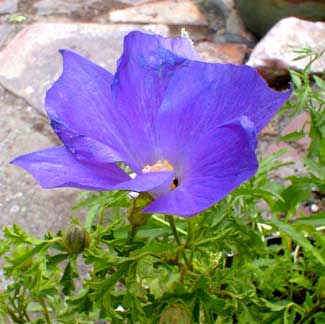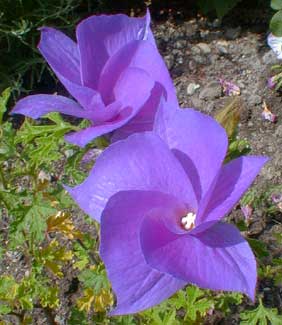
'Santa Cruz'
Australian Blue Hibiscus
"This morn I trod the secret path of dreams,
And, lo! my wilding flowers sprang thick around me."
-Titus Munson Coan
(1801-1882)
(1801-1882)
Even in a crappy garden section like in K-Mart one never knows what will turn up, & as I sauntered through the drying-out poorly cared for most commonplace perennials, I spotted a tiny shrub in a gallon pot, something I'd not seen in any of the major nurseries.
It is rarely offered locally because it isn't actually suitable to our zone. K-Mart doesn't give a gummy-bear about such niceties as zone appropriateness, so there it was without informative tag beyond the shrub's name. But they do have good prices, & at $3, the little shrub was worth the experiment.
Alyogine huegelii is best for zones 9 and 10, ideal & hardy for desert or arid gardens, but not an easy shrub for our temperate maritime climate (USDA Zone 8). It will usually rot during rainy winters, yet so flowery it can be grown even if only as a defacto annual that won't last long enough to become the large woody shrub it ought to be.
 It's worth the attempting in the sunniest location with loose sandy soil on a raised garden ledge, or as a full-afternoon-sun wall-shrub protected by heat from the house, or as a container plant that can be pruned & brought to cover for winter. Winter wetness more than cold is its enemy, though we're also right on the cusp of its cold tolerances. Only time will tell if this $3 shrub adapts sufficiently to last for years, though their usual fate is to do quite well wherever temperatures even through a couple of winter if coldest nights rarely to never fall below about 25 degrees F. Then some year there'll be a real cold-snap down to the teens, & finally the Alyogine will be killed.
It's worth the attempting in the sunniest location with loose sandy soil on a raised garden ledge, or as a full-afternoon-sun wall-shrub protected by heat from the house, or as a container plant that can be pruned & brought to cover for winter. Winter wetness more than cold is its enemy, though we're also right on the cusp of its cold tolerances. Only time will tell if this $3 shrub adapts sufficiently to last for years, though their usual fate is to do quite well wherever temperatures even through a couple of winter if coldest nights rarely to never fall below about 25 degrees F. Then some year there'll be a real cold-snap down to the teens, & finally the Alyogine will be killed.Its name is prounced Ally-OG'unny. The species is name is after the 19th Century Austrian soldier, diplomat, courtier, scholar, & botanist, Baron Karl Alexander Anselm Hugel (1796‚1870). The cultivar "Santa Cruz" is named after the Catholic mystic poet &amap son of a humble silk weaver, San Juan de la Cruz, vis, Saint John of the Cross (1542-1591). San Juan died a martyr, persecuted by his own church so that St. Theresa hid him in a box the size of a coffin in a damp basement cell, resulting in his death by pneumonia. His sin was that of having written beautiful, religiously ecstatic poems "tainted" by the kabbalistic philosophy of Spanish Jews. After he was dead he was forgiven his poems & eventually canonized, but official histories still avoid mentioning his borrowing from the philosophy of Kabbalah.
In a verse like this, San Juan writes in the voice of the erotic Bride after having lain with God:
"Where have have vanished,This is the Divine Shekhinah, Bride of God, likened both by San Juan & by the original Jewish sources as a living presence that is the collective soul of adoring humanity. Her "moan" is the moaning of a dove. God in turn speaks to Her, adjuring the world not to harm Her with Her walled garden. Her husband God does finally hear her pleas & returns to her for the connubial attachment:
Beloved, leaving me to moan?
You fled like a stag
having wounded me;
I am crying to you, but you are gone."
"The bride has enteredIt could be argued that San Juan's vision of a Divine Female coupling with a Divine Male is no more Catholic than is some white suburban youth suddenly a black man because he can gangsta-rap. It it ecstatic Judaism, the sepherotic union of Malkhuth the Lower Shekhinah with Tiphereth (Yahweh) on the Sephiroth Tree
the garden of her sweetest desire,
& there rests in delight,
laying her neck
on the gentle arms of her Beloved."
St John of the Cross & St Theresa lived in a part of the world where this philosophy was best known, & both were doubtless students of Kabbalah. That's exactly why John of the Cross had to be brought to a cruel end. That the Church felt guilty about it afterward & soon thereafter, until the present, lionizes his sacred poetry, is part of a continuing legacy of the Spanish Jewry whom Queen Isabella cast out of Spain, whom the Inquisition tortured, but whose ideas the most spiritual monks & nuns would embrace even at cost of their lives.
In Catholic myth, both San Juan's Divine Bride, & the Virgin Mary, are easily identifiable as one & the same with the Divine Shekhinah. In Spain the Virgin Mary was sometimes akin to a War-goddess used as a paladium carried before Spanish armies, much as in the Holy Zohar of Saphed in Spain, the Divine Lady is described as possessing all the weapons & legions of God, standing upon a battlefield with her head against the moon & her feet in Sheol, a mighty defender of humanity even against the angry face of God, as Theresa stood against the angry face of her own church authority in defense of John. Ah, religions are so cruel, but those caught within it are often as heroic as the Shekhinah Herself.
Mary's sacred color is Blue, & the Shekhinah is likewise most often identified with the color blue. So what better flower than this Australian Blue Hibiscus to receive these associations that represent a surprising harmony between Jew & Christian so far as mystics are concerned, & an even more surprising harmony with Goddess worship even for faiths alleged to be masculinist.
Formerly lumped into the genus Hibiscus, alyogine is still commonly called Blue Hibiscus or Australian Blue Hibiscus, more rarely Lilac Hibiscus or Purple Hibiscus which is closer to the color of the wild shrub. But "Santa Cruz" makes "Blue Hibiscus" less a misnomer, as the big flowers are very nearly truly blue.
Blooms beginning in Spring in the southwest, but not until early summer in the Northwest. "Santa Cruz" produces hundreds of three- to four-inch large & impressive blue to dark violet silvery-hued blooms, with small bright yellow anthers, in full sway by July, & sporadically until autumn. Each bloom only lasts one to three days, but the buds just keep on coming, with new flowers for weeks on end. The petals petals form an overlapping propellor, usually partially closed into a funnel-cup.
"Santa Cruz" is more densely foliaged than many varieties, though still very airy, with toothed, wrinkly, deeply cut three- to five-segment leaves which have a harder look & feel than other varieties. It attempts to remain evergreen even in our cooler climate, though if it makes it through winter, it will need some frost-damaged bits trimmed away in early spring.
The whole genus is native to Australia, A. huegelii from South & Western Australia. The blue & purple forms which are most widely available in Europe & North America, including "Santa Cruz," were developed from what was formerly recognized as Hibiscus huegelii var leptochlamys, but when it was recategorized as Alykogine, the variant forms appear to have been dropped from recognition.
Much as with hibiscus, alyogine requires a periodic pruning or it will get scraggly. Given its legs it is capable of rapidly becoming an eight-foot tall many-branching very airy shrub, probably not more than four feet in the Northwest. It can be kept smaller with regular pruning.
After its first maximum bloom of the year is finished, that's the time to trim it to preserve a more compact look, to improve its overall health, & guarantee its floriferousness. If never pruned, its gangliness will not be pleasant, as it is apt to produce leaves only at the tops & let the lower portion remain bare, but when pruned it keeps producing leaves even on the lower stems.
Though adaptable to almost any reasonable soil type, what Alyogyne cannot abide is poor drainage. Fullest sun with a little protection from harsh winds suits it, & little or no watering once it is established. In the rainy Northwest where it is particularly at risk of rotting away in winter, loose sandy or pebbly soil in a location on a garden ledge gives it a chance of success beyond its one flowery year.
It does not need fertilizing, & it might even be injured by phosphorus. A winter mulch of composted manure or leafmold is the most it requires, both as a feed & as root protection for winter.